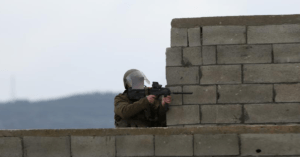Israeli Soldiers Shoot Palestinian and Clash with Protesters in Hebron Area
On Saturday, Israeli soldiers invaded the Al-Fawwar refugee camp south of Hebron in the occupied West Bank. The invasion triggered protests, and the military responded by firing live rounds, rubber-coated bullets, and tear gas. A young Palestinian man was shot in the leg, and many others suffered from tear gas inhalation.
In related incidents, Israeli forces also raided Doura town and the Al-Arroub refugee camp near Hebron, causing more tear gas exposure and live-round injuries. Soldiers also entered Anata town, northeast of Jerusalem, and shot another young man.
In total, at least fourteen Palestinians were abducted, and several others were detained and interrogated by the Israeli military in various parts of the West Bank. The raids and clashes have resulted in widespread unrest and injuries among Palestinian civilians.

Israeli Soldiers Shoot Palestinian and Clash with Protesters in Hebron Area
On Saturday, Israeli soldiers entered the Al-Fawwar refugee camp, located south of Hebron in the occupied West Bank. The soldiers arrived in military vehicles, which led to protests from the local residents. In response to the protests, the soldiers used live ammunition, rubber-coated steel bullets, and tear gas. During the confrontation, a young Palestinian man was shot in the leg, and many others suffered from the effects of tear gas.
The same day, Israeli forces also carried out raids in other areas near Hebron. They entered Doura town and the Al-Arroub refugee camp, where they fired live bullets and tear gas, impacting many people. In addition, soldiers went into Anata town, northeast of Jerusalem, and shot another young man.
Throughout these operations, at least fourteen Palestinians were arrested by the soldiers. Many others were detained and questioned in various parts of the West Bank. These incidents have heightened tensions in the region, as such military actions often lead to clashes and further unrest.
The Al-Fawwar refugee camp, like many other camps in the West Bank, is home to Palestinians who were displaced during previous conflicts. The camp is densely populated, and living conditions are often challenging. The presence of military forces in such areas frequently leads to confrontations, as residents protest against what they see as the occupation of their land.
In Doura town and the Al-Arroub refugee camp, similar scenes unfolded. The use of live ammunition and tear gas by Israeli forces resulted in injuries and widespread discomfort among the local population. The town of Anata, located near Jerusalem, also experienced violence, with another young man being shot during the raid.
The Israeli military has stated that such operations are necessary to maintain security and prevent attacks. However, Palestinians argue that these actions are excessive and contribute to the cycle of violence in the region. The raids often result in arrests, with many Palestinians being taken into custody for questioning. Some are released after interrogation, while others may face longer detentions.
The situation in the West Bank remains tense, with frequent clashes between Israeli forces and Palestinian residents. The use of force by the military often leads to injuries and arrests, further fueling anger and frustration among the Palestinian population. Many Palestinians view these actions as part of a broader effort to control and suppress their communities.
Human rights organizations have repeatedly raised concerns about the use of live ammunition and tear gas in densely populated areas. They argue that such tactics put civilians at risk and often result in unnecessary harm. The ongoing conflict in the region has led to a humanitarian crisis, with many Palestinians living under difficult conditions and facing regular military incursions.
The recent events in Al-Fawwar, Doura, Al-Arroub, and Anata are part of a larger pattern of violence and unrest in the West Bank. The cycle of raids, protests, and clashes shows no signs of ending, as both sides remain deeply entrenched in their positions. For Palestinians, these actions are a reminder of the ongoing occupation and the challenges they face in their daily lives. For Israelis, the operations are seen as necessary measures to ensure security and prevent potential threats.
In summary, the Israeli military’s actions in the West Bank on Saturday resulted in injuries, arrests, and widespread tension. The use of live bullets, rubber-coated steel bullets, and tear gas in refugee camps and towns has once again highlighted the fragile and volatile nature of the situation in the region. The ongoing conflict continues to take a toll on both Palestinian and Israeli communities, with no clear resolution in sight.
You must be logged in to post a comment.